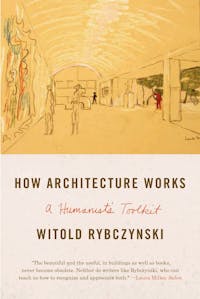How Architecture Works
A Humanist's Toolkit
 Download image
Download image
ISBN10: 0374534829
ISBN13: 9780374534820
Trade Paperback
368 Pages
$20.00
CA$27.25
A Finalist for the Marfield Prize for Arts Writing
Architecture is both setting for our everyday lives and public art form—but it remains mysterious to many. In How Architecture Works, Witold Rybczynski, one of our best, most stylish critics and winner of the Vincent Scully Prize for his architectural writing, answers our most fundamental questions about how good—and not-so-good—buildings are designed and constructed.
Introducing the reader to the rich and varied world of modern architecture, he takes us behind the scenes, revealing how architects as different as Frank Gehry, Renzo Piano, and Robert A. M. Stern envision and create their designs. He teaches us how to "read" plans, how buildings respond to their settings, and how the smallest detail—of a stair balustrade, for instance—can convey an architect's vision. Ranging widely from a war memorial in London to an opera house in St. Petersburg, from the National Museum of African American History and Culture in Washington, D.C., to a famous architect's private retreat in downtown Princeton, How Architecture Works, explains the central elements that make up good building design. It is a humanist's toolkit for thinking about the built environment and understanding architecture as a form of art as well as the setting for our everyday lives.
"Architecture, if it is any good, speaks to all of us," Rybczynski writes. This revelatory book is his grand tour of architecture today.
Reviews
Praise for How Architecture Works
"Master critic Witold Rybczynski's irreverent guide to the greatest buildings of the past and present." —Laura Miller, Salon
"[A] robust tour of architecture . . . Rybczynski is an artful conductor and learned hand who leaves much of the pleasure of architectural discovery to readers." —Kirkus Reviews (starred review)
"In this conversational and invigorating treatise, Rybczynski deepens our understanding of all that goes into the design and construction of buildings . . . [This] expert, holistic, down-to-earth guide awakens us to architecture's profound humanness." —Booklist
"A commanding view of the field . . . Here, architecture is treated as craft executed with prudence and conviction." —Publishers Weekly (starred review)
Reviews from Goodreads
BOOK EXCERPTS
Read an Excerpt
1
IDEAS
The École des Beaux-Arts in Paris, which dominated architectural education in the nineteenth and the early twentieth centuries, developed a strict method of teaching building design. After being...



